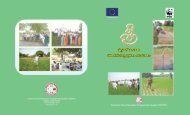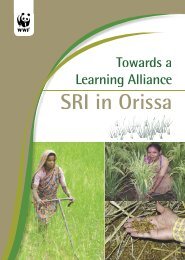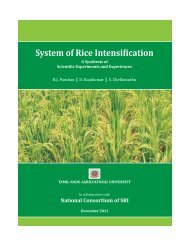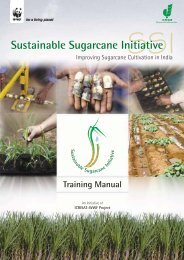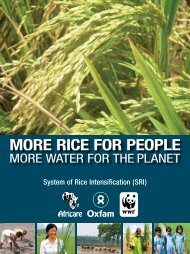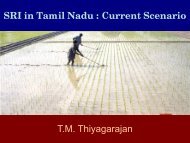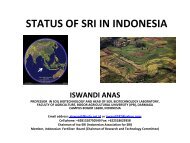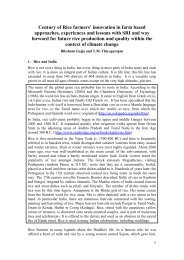SSI Newsletter - SRI - India
SSI Newsletter - SRI - India
SSI Newsletter - SRI - India
You also want an ePaper? Increase the reach of your titles
YUMPU automatically turns print PDFs into web optimized ePapers that Google loves.
Anji Reddy<br />
The New Age Farmer of <strong>SSI</strong><br />
Anji Reddy was able to make use of the knowledge of researchers and<br />
scientists on the one hand and his own experiences on the other to<br />
effectively implement the <strong>SSI</strong> methods in his small plot of land. He took<br />
a bold leap into the Unknown, as it were, and came up smelling roses.<br />
This is his story and his experience with <strong>SSI</strong> which is indeed emulatory.<br />
SugarCane<br />
matters<br />
20<br />
Nov ‘09<br />
At the age of 51, Barur Anji Reddy<br />
is an enthusiastic, practical and<br />
innovative farmer. He is agile, has<br />
keen interest and has the capacities<br />
to go to the core of the problem,<br />
whereby his innovativeness. Life has<br />
completely changed for Anji Reddy<br />
since he implemented the <strong>SSI</strong> method<br />
in his one acre plot which he has now<br />
extended to five acres. In fact, his<br />
field has become a classic model for<br />
<strong>SSI</strong> all over the state for other farmers<br />
to emulate.<br />
The “wonderful magic formula” –<br />
as he calls the <strong>SSI</strong> – has had nearly<br />
500 people visiting his field which<br />
includes farmers, industrial and<br />
factory representatives and media, to<br />
see and learn more from and about<br />
this new and innovative method.<br />
Over the last few months, Anji Reddy<br />
has been featured as an innovative<br />
and progressive farmer in most of the<br />
audio-visual as well as print media.<br />
Anji Reddy, a Graduate in Geology,<br />
lives in Madgi village of Zaheerabad<br />
Mandal in Medak district and<br />
comes from a family dependent on<br />
agriculture. Initially when he began<br />
cultivation, he tried several crops<br />
unsuccessfully and so moved to<br />
sugarcane as it was more resistant to<br />
climatic extremities. He would get 25<br />
to 30 tonnes of sugarcane per acre,<br />
for which he would have to use 5-6<br />
tonnes of cane as setts.<br />
Tryst with <strong>SSI</strong><br />
In 1994-95, he came to know about<br />
the Hapse method of cultivation and<br />
decided to experiment with it in his<br />
Manisha Agarwal<br />
field. In 2006, Anji Reddy went to<br />
Tamil Nadu on an exposure visit and<br />
learnt about new methodologies in<br />
running a nursery. He was introduced<br />
to the ICRISAT-WWF project team<br />
at the same time and was provided<br />
seedlings, training and technical<br />
support. Anji Reddy was able to get<br />
the other materials like shade net,<br />
plastic trays and coco pith. Other<br />
than the materials, he was able to<br />
get lot of technical support also from<br />
the team and he attended several<br />
meetings and workshops during this<br />
period organized by ICRISAT-WWF<br />
Project.<br />
Anji Reddy began <strong>SSI</strong> in 1 acre<br />
as a trial. He expressed that with<br />
the conventional method of cane<br />
cultivation, the problem with finding<br />
labor was immense but with the<br />
new <strong>SSI</strong> method, not so much labor<br />
is required. There is lesser use of<br />
chemical fertilizer as organic compost<br />
is used more and the usage of seed<br />
is less and there is greater saving of<br />
water.<br />
Saving in Seed Material<br />
Today, Anji Reddy uses 2½ tonnes<br />
of cane for his 5 acres of crop. The<br />
yield in this method would then be 80<br />
tonnes and more, if the weather and<br />
climactic conditions are conducive.<br />
By following <strong>SSI</strong>, almost 3.5 tonnes<br />
of canes are left within the field, thus<br />
producing about 3.5 quintals more<br />
sugar per acre.<br />
He says that if the crops were to be<br />
protected carefully for the initial 3<br />
months, then there will be an assured<br />
yield of 100 tonnes per acre (For this<br />
he gives the statistics: 5000 plants X<br />
10 millable canes X2 kg per cane).<br />
Saving in Labour<br />
Anji Reddy says, “In conventional<br />
farming, a sugarcane farmer is<br />
spending more on the laborers as they<br />
are demanding high wages while the<br />
factory owners are refusing to pay<br />
remunerative prices for the cane so<br />
more and more farmers are reduced<br />
to shifting to other lucrative crops.<br />
But if a farmer adopts <strong>SSI</strong>, then<br />
the labour requirement is reduced.<br />
For example: In the conventional<br />
method, if 4 tonnes of cane needs<br />
to be cut for setts, then at least 8<br />
laborers are required at the rate of<br />
2 people for each tonne. Now with<br />
the <strong>SSI</strong> method, not more than 2<br />
people are required as the seed cane<br />
required is just 0.5 tonnes per acre.<br />
Which means a farmer can save up to<br />
50% of labor. Labour requirement is<br />
also reduced during transplantation<br />
and other intercultivation practices<br />
because of wider spacing in the <strong>SSI</strong><br />
methods.”<br />
Intercrops – A Bonus<br />
Intercropping is another practice<br />
which Anji Reddy feels is like a boon<br />
to his field. He says, “if the intercrop<br />
is planted immediately after planting<br />
the sugarcane, then the risk of weeds<br />
growing would come down drastically.<br />
As such there is a need for weeding<br />
only twice within the crop period”.



